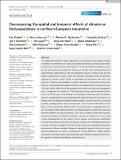Files in this item
Decomposing the spatial and temporal effects of climate on bird populations in northern European mountains
Item metadata
| dc.contributor.author | Bradter, Ute | |
| dc.contributor.author | Johnston, Alison | |
| dc.contributor.author | Hochachka, Wesley M. | |
| dc.contributor.author | Soultan, Alaaeldin | |
| dc.contributor.author | Brommer, Jon E. | |
| dc.contributor.author | Gaget, Elie | |
| dc.contributor.author | Kålås, John Atle | |
| dc.contributor.author | Lehikoinen, Aleksi | |
| dc.contributor.author | Lindström, Åke | |
| dc.contributor.author | Piirainen, Sirke | |
| dc.contributor.author | Pavón-Jordán, Diego | |
| dc.contributor.author | Pärt, Tomas | |
| dc.contributor.author | Øien, Ingar Jostein | |
| dc.contributor.author | Sandercock, Brett K. | |
| dc.date.accessioned | 2022-08-16T16:30:04Z | |
| dc.date.available | 2022-08-16T16:30:04Z | |
| dc.date.issued | 2022-08-14 | |
| dc.identifier | 280645351 | |
| dc.identifier | 2e3b2f0f-3994-40ba-bfde-54b062dc9a08 | |
| dc.identifier | 000840391200001 | |
| dc.identifier | 85135869889 | |
| dc.identifier.citation | Bradter , U , Johnston , A , Hochachka , W M , Soultan , A , Brommer , J E , Gaget , E , Kålås , J A , Lehikoinen , A , Lindström , Å , Piirainen , S , Pavón-Jordán , D , Pärt , T , Øien , I J & Sandercock , B K 2022 , ' Decomposing the spatial and temporal effects of climate on bird populations in northern European mountains ' , Global Change Biology , vol. Early View . https://doi.org/10.1111/gcb.16355 | en |
| dc.identifier.issn | 1354-1013 | |
| dc.identifier.other | RIS: urn:523822EC0959F9ACBEEAA0A7BC89374A | |
| dc.identifier.other | ORCID: /0000-0001-8221-013X/work/117568149 | |
| dc.identifier.uri | https://hdl.handle.net/10023/25857 | |
| dc.description | Funding: The Swedish Bird Survey was supported by grants from the Swedish Environmental Protection Agency, with additional financial and logistic support from the Regional County Boards (Länsstyrelsen). The surveys were carried out within the framework of the strategic research environment Biodiversity and Ecosystem Services in a Changing Climate (BECC). The Norwegian breeding bird monitoring (Norsk hekkefuglovervåking) was financed by the Norwegian Environment Agency and the Ministry of Climate and Environment. Our research was funded through the 2017-2018 Belmont Forum and BiodivERsA joint call for research proposals, under the BiodivScen ERA-Net COFUND programme with financial support from the Research Council of Norway (295767), the Swedish Research Council FORMAS (2018-02440, 2018-02441), the Academy of Finland (323527, 326327, 326338) and the U.S. National Science Foundation (ICER-1927646). | en |
| dc.description.abstract | The relationships between species abundance or occurrence versus spatial variation in climate are commonly used in species distribution models (SDMs) to forecast future distributions. Under "space-for-time-substitution", the effects of climate variation on species are assumed to be equivalent in both space and time. Two unresolved issues of space-for-time-substitution are the time period for species' responses and also the relative contributions of rapid- versus slow reactions in shaping spatial and temporal responses to climate change. To test the assumption of equivalence, we used a new approach of climate decomposition to separate variation in temperature and precipitation in Fennoscandia into spatial, temporal and spatio-temporal components over a 23-year period (1996-2018). We compiled information on land cover, topography and six components of climate for 1756 fixed route surveys and we modelled annual counts of 39 bird species breeding in the mountains of Fennoscandia. Local abundance of breeding birds was associated with the spatial components of climate as expected, but the temporal and spatio-temporal climatic variation from the current and previous breeding seasons were also important. The directions of the effects of the three climate components differed within and among species, suggesting that species can respond both rapidly and slowly to climate variation and that the responses represent different ecological processes. Thus, the assumption of equivalent species' response to spatial and temporal variation in climate was seldom met in our study system. Consequently, for the majority of our species, space-for-time substitution may only be applicable once the slow species' responses to a changing climate have occurred. Whereas forecasts for the near future need to accommodate the temporal components of climate variation. However, appropriate forecast horizons for space-for-time substitution are rarely considered and may be difficult to reliably identify. Accurately predicting change is challenging because multiple ecological processes affect species distributions at different temporal scales. | |
| dc.format.extent | 19 | |
| dc.format.extent | 4533378 | |
| dc.language.iso | eng | |
| dc.relation.ispartof | Global Change Biology | en |
| dc.subject | Anticipatory forecasts | en |
| dc.subject | Climate decomposition | en |
| dc.subject | Dynamic forecasts | en |
| dc.subject | Forecast horizon | en |
| dc.subject | Space-for-time substitution | en |
| dc.subject | Spatio-temporal forecasting | en |
| dc.subject | Spatio-temporal pattern | en |
| dc.subject | Species distribution models | en |
| dc.subject | Static forecasts | en |
| dc.subject | HA Statistics | en |
| dc.subject | QH301 Biology | en |
| dc.subject | DAS | en |
| dc.subject | SDG 13 - Climate Action | en |
| dc.subject | SDG 15 - Life on Land | en |
| dc.subject.lcc | HA | en |
| dc.subject.lcc | QH301 | en |
| dc.title | Decomposing the spatial and temporal effects of climate on bird populations in northern European mountains | en |
| dc.type | Journal article | en |
| dc.contributor.institution | University of St Andrews. Statistics | en |
| dc.contributor.institution | University of St Andrews. Centre for Research into Ecological & Environmental Modelling | en |
| dc.identifier.doi | 10.1111/gcb.16355 | |
| dc.description.status | Peer reviewed | en |
This item appears in the following Collection(s)
Items in the St Andrews Research Repository are protected by copyright, with all rights reserved, unless otherwise indicated.

